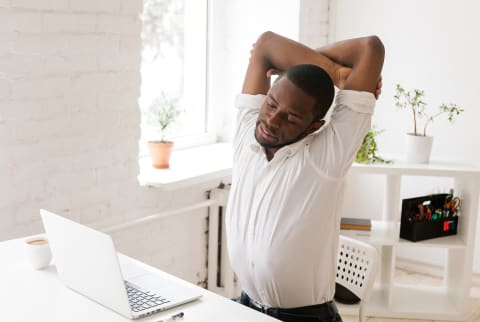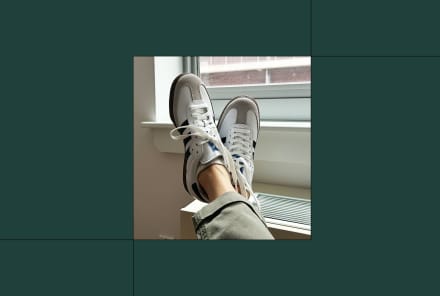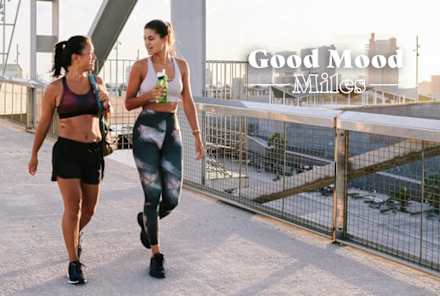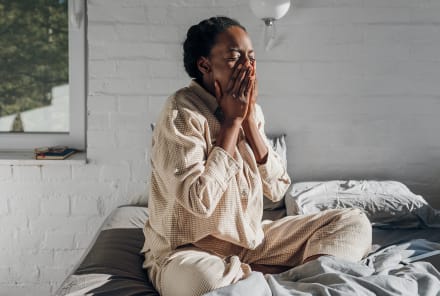Advertisement
14 Stretches To Counteract The Effects Of Sitting, From A Physical Therapist


It's hard to believe something as innocuous as sitting could be dangerous. But as it turns out, it can be. With many people working desk jobs or attending school online, the amount of time spent sitting can really add up.
Aiming to have a less sedentary lifestyle overall is important, but for those days when you are sitting for longer hours, some stretches can be helpful. As a physical therapist, here's what I tell my patients about the importance of standing, along with some stretches I often recommend to improve range of motion, relieve tightness, and prevent muscle loss.
Why is sitting dangerous?
The U.S. Department of Health and Human Services gathered data from current studies to update its Physical Activity Guidelines for Americans—and a couple of findings were a little worrisome.
The first is a little less surprising: In the last decade or so, the number of Americans who meet the recommended aerobic exercise guideline (150 to 300 minutes per week) hasn't increased much. Over the span of eight years, the percentage has only risen from 63.2% to 65.2%.
A second more startling point is, as a country, we have become even more sedentary1. In 2008 we sat on average 5.7 hours a day, and by 2016 it increased to 6.4 hours per day.
The research is unequivocally clear: Prolonged sitting is bad. The World Health Organization (WHO) now lists "insufficient physical activity" as a leading risk factor for preventable mortality. Sitting and inactivity are associated with type 2 diabetes, cardiovascular disease, cancer, depression, blood clots, Alzheimer's disease, metabolic syndrome, and mortality. Extended sitting is also hard on our muscles, joints, bones, and posture.
While promoting movement is important always, the COVID-19 pandemic has aggravated inactivity. Unemployment, working from home, closed gyms, and increased screen time have only amplified sitting time.
So what do we do about this sitting problem?
So what do we do if our life or job requires prolonged sitting? Well, it really doesn't take too much. Research suggests that just brief periods of standing (or even kneeling and squatting) can be beneficial throughout the day. I recommend a 30-by-30 rule, which reminds people to stand up for at least 30 seconds, every 30 minutes.
If your space allows, stretching your neck, shoulders, and spine while standing can also help. Utilize your desk or chair to help stretch the legs and back, raise up and down on your toes, or do some squats or pushups against the wall.
Prioritizing our health, vitality, and longevity requires us to not only increase our activity time but also decrease our sitting time. Remember, something is always better than nothing when it comes to movement.
Stretches to minimize the effects of sitting:
For mobility and range of motion.
I recommend doing these exercises one to four times, every day. Each movement should create a gentle stretch sensation. Complete 5 to 10 repetitions of each.
- Neck rotations: Rotate your neck left and right slowly, then up and down slowly as far as comfortable.
- Shoulder shrugs: Shrug your shoulders forward and backward.
- Trunk rotation and side stretch: Reach both arms to the ceiling and slowly rotate your spine to the left and to the right. Then side bend to the left and right, slowly.
- Gentle backbend: Place your hands in the small of your back and gently bend your spine backward.
To relieve muscle stiffness or tightness.
I recommend doing these stretches one to four times every day. They should create a mild to moderate pull sensation and you can hold them for 20 to 30 seconds. When you are done with the activity, you should either feel the same or better. Complete up to 4 repetitions of each.
For the lower back:
- Knee-to-chest stretch: Sit down, gently bring one knee to your chest, and hold.
- Seated low-back stretch: Sit down, gently bend forward, lowering your hands to the floor between your knees, and hold.
- Seated piriformis stretch: Sit down, place your right foot over your left knee. Then pull your right knee toward your left shoulder, and hold. (You should feel this in the right butt cheek.) Repeat on the other side.
- Standing low-back stretch: Stand, rest your hands on a desk or chair back, and bend forward at the waist to stretch your low-back and hamstring muscles.
For the legs:
- Sitting quad stretch: Sit down and move to the right side of your chair. Put your right toes back and bend your right knee. You should feel a stretch in the front of the thigh. Repeat on the left side.
- Standing quad stretch: While standing (with support as needed), put your right foot on the chair seat behind you and bend the right knee to feel a pull in the front of the thigh. Repeat on the left side.
To decrease loss of muscle strength.
I recommend doing these exercises one to four times a day, three times per week. Complete 10 to 30 repetitions of each.
- Heel raises: Standing, rise up onto your toes. Hold for one count, then lower. For a challenge, work one leg at a time
- Squats: Standing, squat to a comfortable point. Hold for one count and rise back to standing.
- Wall pushups: Stand 2 to 3 feet from a wall. Place your two hands on the wall just below chest level. Keeping your body straight, lower your nose to the wall, hold for one count, and push back out again.
- Single leg standing: Stand on one foot for 15 seconds. Repeat on the other leg.
Incorporating these simple yet effective stretches into your routine can have a positive impact on your tight muscles, mobility, and overall well-being.











